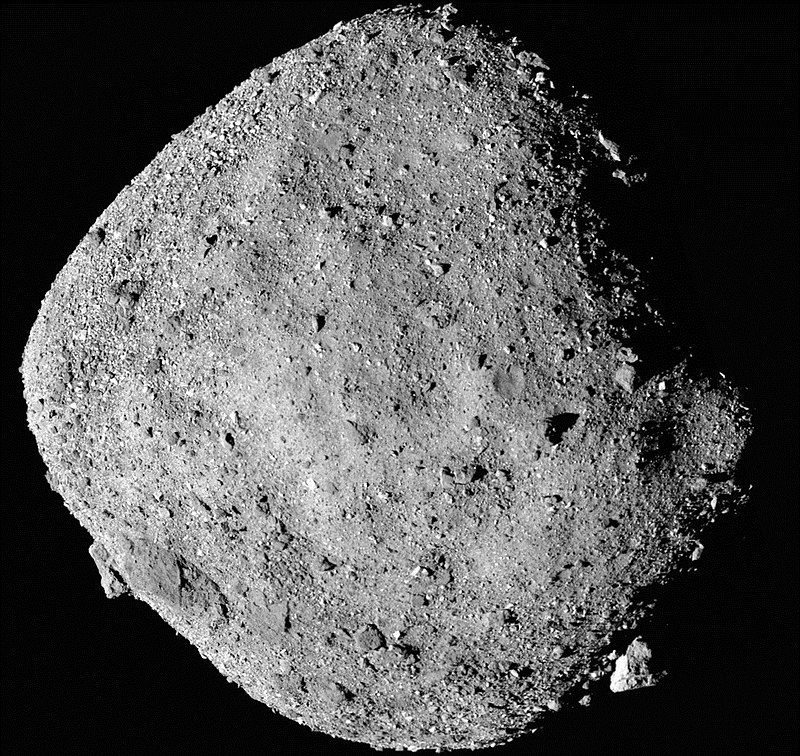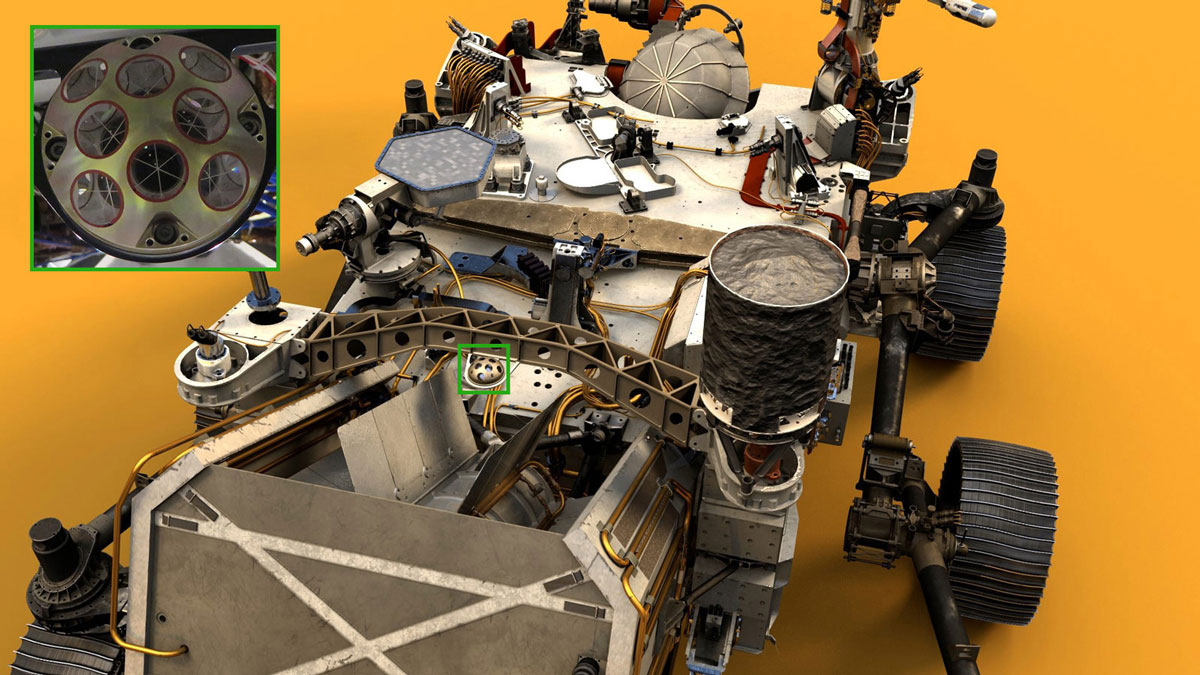 | ||
| Asteroid 101 955 Bennu, compiled from 12 images photographed by NASA's OSIRIS-REx mission on 2018 December 2. (Image Sources: NASA, Wikipedia.org, By NASA/Goddard/University of Arizona - https://www.nasa.gov/press-release/nasa-s-newly-arrived-osiris-rex-spacecraft-already-discovers-water-on-asteroid; see also https://www.asteroidmission.org/?attachment_id=12476, Public Domain, https://commons.wikimedia.org/w/index.php?curid=74979917) |
By Glenn A. Walsh
Reporting for SpaceWatchtower
Early Tuesday evening, NASA's OSIRIS-REx probe will “TAG” asteroid Bennu, collecting rocks and dust samples for an eventual return to Earth. On-line, NASA-TV will provide live coverage of the event.
The OSIRIS-REx mission has been in orbit of asteroid 101955 Bennu since 2018 December 3, after launching from Cape Canaveral, Florida on 2016 September 8. It has taken two years to survey and map the asteroid's surface, to determine good sites for the TAG (Touch-and-Go) maneuver.
The asteroid is much rockier than expected. The “Nightingale” site chosen for the landing is only the size of a few parking spaces. If the first TAG does not succeed, OSIRIS-REx has only two other chances to attempt a sample collection, possibly at other sites. To stir-up rocks and dust samples, the probe carries three pressurized nitrogen canisters to fire at the collection site, from the end of the probe's robotic arm, one canister for each collection attempt.
Descending to the surface of Bennu will
take about four hours, about the same time as one rotation of the
asteroid on its axis. However, after descent, the TAG sample
procedure will be quite short: only 16 seconds! After each collection attempt, the space probe will hover above the site to determine if the attempt was successful, before either attempting again or returning to orbit.
After successfully collecting material from Bennu, OSIRIS-REx will slowly launch into orbit of the asteroid, where it will stay for the rest of this year. Next year, OSIRIS-REx will begin the journey home, with the Bennu sample materials, which is expected to take about two years.
OSIRIS-REx is expected to land in the Utah desert on 2023 September 24. The spacecraft and Bennu samples will then be recovered and taken for study by scientists.
Bennu is considered a "rubble pile" asteroid, formed in the deep past, possibly near the time our Solar System was formed. Gravity slowly forced remnants of collisions of material to come together forming this asteroid. Bennu looks something like a spinning top, with a diameter of about 0.33 statute mile / 500 meters.
Bennu has a slight chance of hitting the Earth in the distant future. In fact, NASA ranks Bennu as the second-most likely asteroid to hit Earth, perhaps sometime in the last 25 years of the 22nd century. Although, even this chance is rather remote.
Determining Bennu's orbit of the Sun, which varies, is important for a final determination if the asteroid could impact the Earth sometime in the future. The orbit of Bennu changes due to the heating of the Sun-side of the asteroid, and then this solar energy is dissapated into Outer Space when that side of the asteroid turns away from the Sun.
Last month, NASA reported that scientists have discovered that some meteorites from the asteroid 4 Vesta have been found on Bennu. “We found six boulders ranging in size from 5 to 14 feet (about 1.5 to 4.3 meters) scattered across Bennu’s southern hemisphere and near the equator,” said Daniella DellaGiustina of the Lunar & Planetary Laboratory, University of Arizona, Tucson. “These boulders are much brighter than the rest of Bennu and match material from Vesta.”
NASA's OSIRIS-REx science team also recently reported that Bennu observations have led to a conclusion that some of the carbon-rich materials of the asteroid could have seeded Earth with the chemicals necessary for the beginning of life. These conclusions came from six studies published in the journals Science and Science Advances on October 8.
Two Japanese missions have accomplished similar asteroid sample return missions in the recent past. The Hayabusa spacecraft returned tiny grains from asteroid 25143 Itokawa in 2010. Hayabusa-2 returned shrapnel from asteroid Ryugu last year.
Live coverage of the event begins on NASA-TV at 5:00 p.m. Eastern Daylight Saving Time (EDT) / 21:00 Coordinated Universal Time (UTC) on Tuesday, 2020 October 20. Touch-down of the spacecraft is expected at about 6:12 p.m. EDT / 22:12 UTC.
NASA-TV: Link >>> https://www.nasa.gov/multimedia/nasatv/index.html#public
Internet Links to Additional Information:
NASA OSIRIS-REx Mission:
Link 1 >>> https://www.nasa.gov/osiris-rex
Link 2 >>> https://en.wikipedia.org/wiki/OSIRIS-REx
Asteroid 101955 Bennu: Link >>> https://en.wikipedia.org/wiki/101955_Bennu
Asterioid 4 Vesta: Link >>> https://en.wikipedia.org/wiki/4_Vesta
Source:
Glenn A. Walsh Reporting for SpaceWatchtower,
a project of Friends
of the Zeiss.
Monday, 2020 October 19.
Like This Post? Please
Share!
More
Astronomy & Science News - SpaceWatchtower Twitter
Feed:
Link >>> https://twitter.com/spacewatchtower
Astronomy & Science Links: Link >>>
http://buhlplanetarium.tripod.com/#sciencelinks
Want to receive SpaceWatchtower blog
posts in your in-box ?
Send request to < spacewatchtower@planetarium.cc
>.
gaw
Glenn A. Walsh, Informal Science Educator &
Communicator:
< http://buhlplanetarium2.tripod.com/weblog/spacewatchtower/gaw/ >
Electronic
Mail: < gawalsh@planetarium.cc >
Project
Director, Friends of the Zeiss:
< http://buhlplanetarium.tripod.com/fotz/ >
SpaceWatchtower
Editor / Author: < http://spacewatchtower.blogspot.com/ >
Formerly
Astronomical Observatory Coordinator & Planetarium Lecturer,
original Buhl Planetarium & Institute of Popular Science (a.k.a.
Buhl Science Center), Pittsburgh's science & technology museum
from 1939 to 1991.
Formerly Trustee, Andrew Carnegie Free Library
and Music Hall, Pittsburgh suburb of Carnegie, Pennsylvania.
Author
of History Web Sites on the Internet --
* Buhl Planetarium,
Pittsburgh: < http://www.planetarium.cc > Buhl Observatory: < http://spacewatchtower.blogspot.com/2016/11/75th-anniversary-americas-5th-public.html >
*
Adler Planetarium, Chicago: < http://adlerplanetarium.tripod.com >
*
Astronomer, Educator, Optician John A. Brashear: < http://johnbrashear.tripod.com >
*
Andrew Carnegie & Carnegie Libraries: < http://www.andrewcarnegie.cc >


